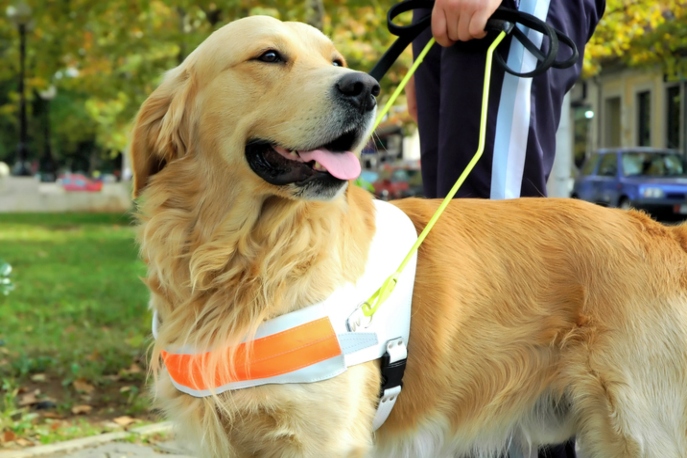Photo Credit: bobbymn
There’s one group that’s always hard at work, yet don’t necessarily get acknowledged…guide dogs. Guide dogs are such an important part of our society for how they can empower the visually impaired to navigate parts of our inherently ableist culture.
On the last Wednesday of every April, the International Guide Dog Federation uses International Guide Dog Day to celebrate, “the work of guide dogs around the world and raise awareness of the importance of guide dog services to help people who are blind or have low vision live life on their terms.”
Roughly 5 percent of people who have a visual impairment use a guide dog in the United States. For these guide dog users, they encounter many misunderstandings about their animals and how they should be integrated in a public setting. Guide dogs are just one type of service dog (others include Hearing/Signal Dogs, Psychiatric Service Dogs, Sensory Signal Dogs/Social Signal Dogs, and Seizure Response Dogs), and all of these dogs are now being looked at with intense scrutiny as the trend of people faking service animal status to take their pets on flights, in restaurants, and other areas of public life. This practice not only misrepresents these animals, but makes life actively more difficult for those that actually need to use them for accommodation purposes.
Since guide dogs are already covered by the Americans with Disabilities Act, it is an organization’s obligation to take the time to understand the lasting importance guide dogs have to their users to navigate their everyday. Below we’ve laid out how employers can learn about how to accommodate guide dogs so that they can make the lives of their users either applying to or currently working at their company easier.
Accept Guide Dogs in Job Interviews
While public job fairs are typically ADA compliant, one-on-one interviews might not be by default. Upon inviting an applicant for an in-person interview, be sure to ask ahead of time if they would like to request any accommodation for a disability. If the applicant does not provide notice and brings in their guide dog, we would recommend proceeding with the interview. Employers may ask some questions about the guide dog as it relates to the ability to complete the job (i.e. the position requires someone to go in areas unsafe for animals, the animal might be cause for germ contamination concerns, etc.), but the primary focus of the interview should be on the applicant themselves. See Job Accommodation Network’s article, “Taking a Service Animal to a Job Interview: Public Access or Reasonable Accommodation?” to learn more.
Educate Employees About Guide Dog Etiquette
Dogs can be a novel and exciting addition to the workplace, but even the most dog-loving employees must keep in mind that these furry friends are working too. As such, it would behoove any employer with a guide dog at the organization to share amongst colleagues the importance of guide dog etiquette. This includes not petting the dog, not calling out to or distracting the dog, and not walking too closely to the dog while they are guiding their owner. If a colleague wants to interact with the dog in any way, they must always ask the dog’s owner for permission and accept a “no” graciously if it’s expressed.
Factor Guide Dogs into Emergency Plans
Companies and organizations have emergency drills and procedures, and it is of the utmost importance that people with disabilities are factored in to these. Evacuation and sheltering plans should be created or adapted under the assumption that animal and owner would not be separated during these events. Owners should also be invited to collaborate with their employer in their emergency preparedness planning. Please review some more helpful tips from the article, “Aiding Individuals with Service Animals During an Emergency”, courtesy of the U.S. Department of Labor’s Office of Disability Employment Policy.
Provide Reasonable Accommodations for Guide Dogs in the Work Area
Most importantly, an employer should make an employee with a guide dog feel welcome by allowing for reasonable accommodation at their workstation. This includes allowing the employee to take their dog on bathroom breaks, putting down water bowls in an appropriate location, and factoring in the safety of the animal while designating where they should go. Please look into the Business Disability Forum’s article, “Supporting employees with guide dogs, assistance animals and emotional support animals” to learn more.
Note: While accommodations must be made for employees with disabilities, it is also important to consider any pet allergies colleagues may have and how best to accommodate them with the introduction of an animal in the workspace. Please see the Job Accommodation Network‘s article to learn about potential ways to meet this issue in a fashion that meets the needs of both parties.
This International Guide Dog Day, we hope to see many companies affirm their commitment to accommodating people with disabilities, educate others about this topic, and value the contribution of their furry team members!
RALIANCE is a trusted adviser for organizations committed to building cultures that are safe, equitable, and respectful. RALIANCE offers unparalleled expertise in serving survivors of sexual harassment, misconduct, and abuse which drives our mission to help organizations across sectors create inclusive environments for all. For more information, please visit www.RALIANCE.org.

